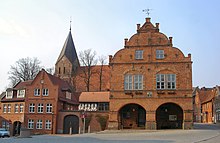District of Gadebusch

The Gadebusch district was a district in the Schwerin district in the GDR . From May 17, 1990, it continued as the district of Gadebusch . Since June 12, 1994, his area has belonged to the district of Northwest Mecklenburg in Mecklenburg-Western Pomerania . The seat of the district administration was in Gadebusch .
geography
location
The ground moraine landscape of the district is a legacy of the last Ice Age. Glacier advances created terminal moraine hills , which near Gottesgabe-Rosenhagen in Hellberg 92 m above sea level. Reach NN . The rivers Maurine , Radegast and Stepenitz cross the area of the district from south to north . Shields and brews arise in the south , flowing in the direction of the Elbe and thus on the other side of the North Sea-Baltic watershed . The western border of the district also formed the inner-German border . The section in the district of Gadebusch ran from the Großer Ratzeburger See via the Mechower See , the Lankower See and the Goldensee to the Niendorfer Binnensee , the northernmost branch of the Schaalsee .
Area and population
The area of the district was 536 km². That corresponded to 6.2% of the area of the Schwerin district.
The population of the district was around 24,400 in 1985. That was 4.1% of the residents of the district. The population density was 46 inhabitants per km².
Neighboring areas
The Gadebusch district in the north-west of the Schwerin district bordered the Duchy of Lauenburg ( Schleswig-Holstein ) in the west, the Hagenow district in the south, the Schwerin-Land district in the east and the Grevesmühlen district in the north .
history
The Mecklenburg district was created when the federal states were dissolved on July 25, 1952 from the western part of the Schwerin district , the southern outskirts of the Grevesmühlen district (until 1950 Schönberg district ) and the Rögnitz community of the Hagenow district and was assigned to the newly formed Schwerin district. The district came to the newly founded state of Mecklenburg-Western Pomerania on October 3, 1990 within the accession area to the Federal Republic of Germany . On June 12, 1994, the district (referred to as the district since May 17, 1990) was dissolved and together with the districts of Wismar and Grevesmühlen, which were also dissolved, and parts of the former districts of Schwerin-Land and Sternberg, the district of Northwest Mecklenburg, which still exists today .
Economy and Infrastructure
The district was a decidedly agricultural area. In addition to the cultivation of sugar beet and grain, there were some industrial livestock farms, such as Rehna, Gadebusch, Reinhardtsdorf and Kirch Grambow.
The remoteness of the circle Gadebusch in the extreme northwest of the GDR brought restrictions for residents in the border areas only with special laissez-passer in the boundary restricted area could stop them.
The most important street in the district was the long-distance road 104 ( Selmsdorf - Rehna - Gadebusch - Schwerin ) and the branch line running parallel from Rehna to Schwerin. The F 208 ran - unlike today - from Rehna about Carlow for Lueders Strand district Herrnburg where they face Lübeck ended on the inner German border.
photos
Castle in Lützow
former watermill in mills Eichsen
Church in Badow
Railway station in Gadebusch
cities and communes
On October 3, 1990, the district of Gadebusch had 32 communities, two of which were cities:
License Plate
Motor vehicles (with the exception of motorcycles) and trailers were assigned three-letter distinguishing signs starting with the pair of letters BB from around 1974 until the end of 1990 . The last number plate series used for motorcycles was BT 95–01 to BT 99–99 .
At the beginning of 1991 the district received the distinguishing mark GDB . It was issued until June 11, 1994. Since April 2, 2013, it has been available in the north-west Mecklenburg district due to license plate liberalization .
Individual evidence
- ↑ a b Federal Statistical Office (ed.): Municipalities 1994 and their changes since 01.01.1948 in the new federal states . Metzler-Poeschel, Stuttgart 1995, ISBN 3-8246-0321-7 .
- ↑ Law on the self-administration of municipalities and districts in the GDR (municipal constitution) of May 17, 1990
- ↑ Andreas Herzfeld: The history of the German license plate . 4th edition. German Flag Society V., Berlin 2010, ISBN 978-3-935131-11-7 , pp. 301 .
- ↑ Andreas Herzfeld: The history of the German license plate . 4th edition. German Flag Society V., Berlin 2010, ISBN 978-3-935131-11-7 , pp. 551 .





